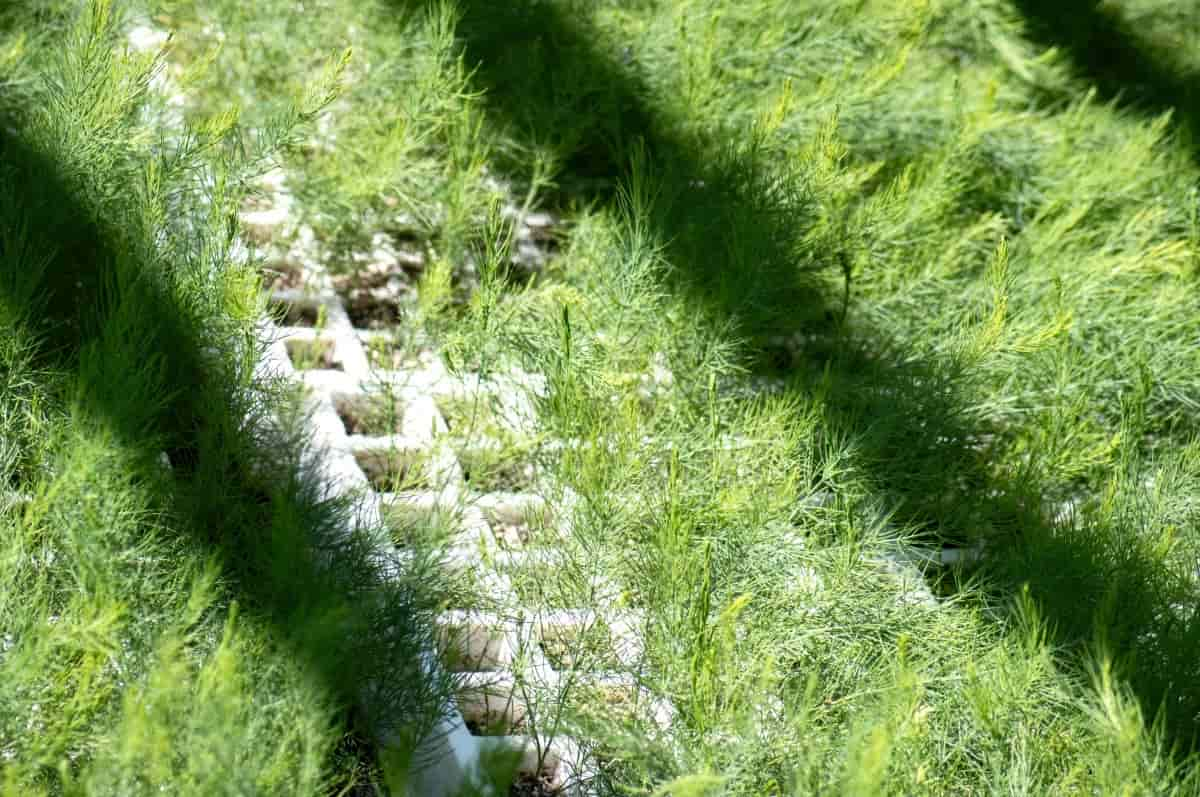Asparagus, a perennial favorite in home gardens, demands specific care and attention to thrive. Whether you’re planting asparagus crowns, growing asparagus in containers, or nurturing it in raised beds, understanding the unique requirements of these plants is crucial. From watering schedules to fertilizer application and mulching techniques, each aspect plays a vital role in the development of young asparagus plants.

This guide dives into the intricacies of providing the ideal environment for asparagus, highlighting how to grow asparagus from cuttings, the right depth for planting asparagus crowns, and how to ensure a bountiful harvest. With patience and proper care, asparagus can be a rewarding addition to your garden, offering fresh spears for many seasons.
Caring for Young Asparagus Plants
Understanding the Watering Needs of Young Asparagus Plants
Watering young asparagus plants is crucial for their growth, but it’s important to avoid overwatering. Asparagus, a perennial plant, thrives in well-drained soil. Young asparagus plants need consistent moisture, especially during their first two growing seasons. Deep, infrequent watering encourages deeper root growth, which is vital for the long-term health of the plant. If you’re growing asparagus in raised beds or containers, be mindful that these environments may require more frequent watering due to faster soil drying.
The Art of Fertilizing Young Asparagus Plants: Dos and Don’ts
Fertilizing young asparagus plants is a delicate balance. In their initial growth phase, a balanced, all-purpose fertilizer can be beneficial. Apply it sparingly in the spring as new growth appears. Prevent excessive fertilization to maintain strong spear growth and reduce vulnerability to diseases. When considering how to grow asparagus at home, especially in containers or raised beds, a well-timed fertilizer application can make a significant difference in the plant’s health and yield.
Mulching Techniques for Young Asparagus Plants: Best Practices
Mulching is vital for asparagus plant health. It helps retain soil moisture, suppresses weeds, and adds organic matter to the soil. Organic mulches, such as straw or compost, are excellent choices. They not only maintain soil temperature but also gradually enrich the soil as they decompose. When mulching asparagus plants, spread the mulch evenly around the plants, taking care not to bury the crowns. This practice is particularly important when learning how to grow asparagus from cuttings or asparagus crowns, as these methods require careful soil management.
Creating the Ideal Soil Moisture Levels for Young Asparagus Plants
Ensuring optimal soil moisture is critical for young asparagus plants. The objective is to maintain consistent soil moisture without excessive saturation, as overly damp soil can result in root rot and other diseases. For those growing asparagus in raised beds or containers, it’s important to ensure good drainage while maintaining consistent moisture. Checking the soil moisture regularly, either by touch or with a moisture meter, can help in managing the watering needs effectively.
In case you missed it: How and When to Fertilize Asparagus Plants: Requirements and Recommendation

Choosing the Right Fertilizer for Young Asparagus Plants
Selecting the right fertilizer for young asparagus plants can significantly impact their growth. A balanced, all-purpose fertilizer is generally recommended. As the plants grow older, they could benefit from a fertilizer with increased phosphorus and potassium content, as these nutrients promote both root and shoot growth. It’s essential to follow the manufacturer’s instructions on application rates and frequency to avoid nutrient imbalances, which can be detrimental to asparagus plants.
Organic Mulching Methods for Young Asparagus Plants
Organic mulching is an excellent way to care for young asparagus plants. Materials like straw, grass clippings, or aged compost not only conserve moisture but also add nutrients to the soil as they decompose. Mulch also helps regulate soil temperature, an important factor in asparagus growth. Spread organic mulch around the plant bases, ensuring not to cover the crowns. This is especially helpful for asparagus grown from cuttings or crowns, as it provides a stable environment for root establishment.
Watering Schedule for Young Asparagus Plants: A Comprehensive Guide
A consistent watering schedule is vital for young asparagus plants. In the initial two years of growth, asparagus necessitates consistent watering to establish a robust root system. The watering frequency should be determined by variables such as soil composition, weather conditions, and whether the plants are in the ground, raised beds, or containers.
In case you missed it: 12 Common Problems With Asparagus Plants: Treatment and Solutions

Typically, watering once or twice weekly to reach a depth of approximately 6-8 inches is recommended. Nevertheless, in hotter and drier climates, more frequent watering may be required. It is essential to regularly assess soil moisture levels and adapt the watering regimen as needed to promote the vigorous growth of your asparagus plants.
Nutrient Requirements of Young Asparagus Plants
Understanding the nutrient needs of young asparagus plants is key to their healthy development. These plants require a balanced diet of nitrogen, phosphorus, and potassium, which are fundamental for growth, root development, and overall health. In the early stages, a higher nitrogen concentration can boost foliage growth, essential for photosynthesis and energy production. As the plant matures, the emphasis shifts towards phosphorus and potassium to support root and spear development.
The Role of Mulch in Protecting Young Asparagus Plants
Mulch plays a critical role in the health and protection of young asparagus plants. Mulching helps in maintaining soil moisture, which is crucial for asparagus plants, especially when learning how to grow them at home, whether in containers, raised beds, or directly in the ground. Opt for organic mulches such as straw or wood chips, as they gradually decompose, enriching the soil with organic material and promoting a favorable soil ecosystem, which is advantageous for asparagus cultivation.
Fertilizer Application Techniques for Optimal Growth of Young Asparagus Plants
Effective fertilizer application is vital for the optimal growth of young asparagus plants. Typically, fertilizer should be applied in early spring when the spears begin to emerge. For asparagus grown in raised beds or containers, using a water-soluble fertilizer can offer more controlled and uniform nutrient distribution.
In case you missed it: How to Grow Asparagus Hydroponically: A Step-By-Step Guide

Ensure that you distribute granular fertilizer evenly at the plant base, taking care to avoid direct contact with spears or crowns. This prevents burning the plants and ensures nutrients are available at the root zone where they’re most needed. Regular soil testing can guide the frequency and type of fertilizer needed, ensuring the plants receive the right nutrients at the right time for their growth stage.
Conclusion
Caring for young asparagus plants is a journey of patience and precision. By mastering the essentials of watering, fertilizing, and mulching, you can ensure the healthy growth and longevity of your asparagus plants. Whether you’re a novice learning how to grow asparagus at home or an experienced gardener refining your techniques, the rewards of this endeavor are manifold. Remember, asparagus is a long-term crop, requiring years to establish fully, but the wait is worthwhile. With the right care, these plants can be produced for up to 20 years, making them a valuable and long-lasting component of any garden.
- Feed Your Flock for Less: Top 10 Tips to Save on Chicken Feed
- Ultimate Guide to Ossabaw Island Hog: Breeding, Raising, Diet, and Care
- Hatching Answers: The Top 10 Reasons Your Chickens Aren’t Laying Eggs
- Eggs and Economics: Breaking Down the Cost of Raising Backyard Chickens
- Defend Your Greens: Proven Methods to Keep Iguanas Out of Your Garden
- Ultimate Guide to Cinnamon Queen Chicken: A Comprehensive Guide for Beginners
- Ultimate Guide to California Tan Chicken: Breeding, Raising, Diet, Egg-Production and Care
- Ultimate Guide to Marsh Daisy Chicken: Breeding, Raising, Diet, and Care
- 10 Types of Chicken Farming Businesses You Can Start for Profits